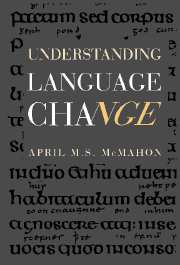Book contents
- Frontmatter
- Contents
- Preface and acknowledgements
- 1 Introduction
- 2 Three views of sound change
- 3 Sound change 2: the implementation problem
- 4 Morphological change
- 5 Syntactic change 1: the Transparency Principle
- 6 Word order change and grammaticalisation: language change and general laws
- 7 Semantic and lexical change
- 8 Language contact
- 9 Linguistic variation
- 10 Pidgins and Creoles
- 11 Language death
- 12 Linguistic evolution?
- Bibliography
- Index
9 - Linguistic variation
Published online by Cambridge University Press: 05 June 2012
- Frontmatter
- Contents
- Preface and acknowledgements
- 1 Introduction
- 2 Three views of sound change
- 3 Sound change 2: the implementation problem
- 4 Morphological change
- 5 Syntactic change 1: the Transparency Principle
- 6 Word order change and grammaticalisation: language change and general laws
- 7 Semantic and lexical change
- 8 Language contact
- 9 Linguistic variation
- 10 Pidgins and Creoles
- 11 Language death
- 12 Linguistic evolution?
- Bibliography
- Index
Summary
Introduction
In this chapter, we return to the problems of the actuation (or initiation) and implementation (or transmission) of change which have been at least a background concern throughout this book. In Chapter 3, we considered a partial solution to the implementation problem, namely the model of lexical diffusion which assumes that at least some changes spread gradually across the set of eligible lexical items. However, this still does not resolve the issue of how or why changes move from speaker to speaker. We have also failed so far to find any satisfactory account of actuation; the schools of theoretical linguistics we have studied have all attempted, more or less successfully, to explain why changes take the particular courses they do once they have begun, but none is able to explain that beginning. For instance, the Structuralist notions of function and structure may tell us why the Great Vowel Shift proceeded through the vowel system in the way it did, but not why the first vowel shifted in the first place. In this chapter, we shall attempt to solve these problems by invoking linguistic variation, which many historical linguists now see as inextricably linked with language change. Our conclusion will be that studies of variation do enlighten us as far as transmission is concerned: the actuation problem, sadly, will remain as mysterious as ever, and we shall consider arguments that this issue may even be outside the domain of historical linguistics.
- Type
- Chapter
- Information
- Understanding Language Change , pp. 225 - 252Publisher: Cambridge University PressPrint publication year: 1994



